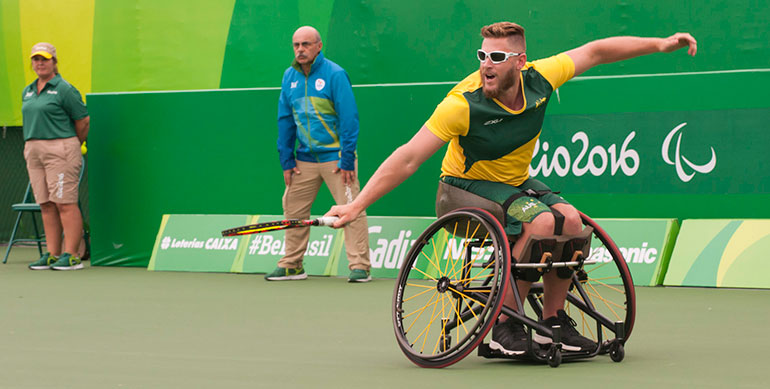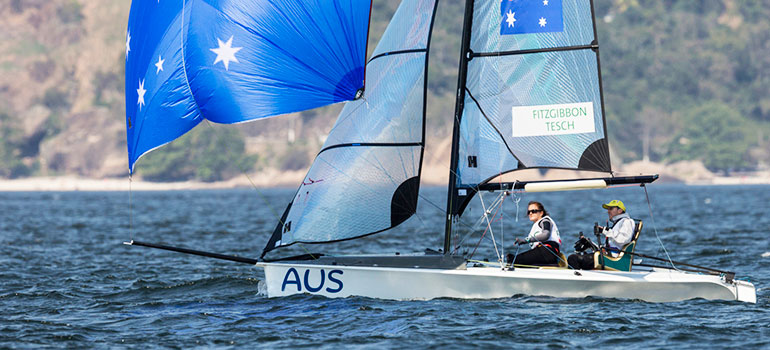Share:
Take it offline!
This Education in Motion resource is also available as a printable PDF.
Download PDF
The Paralympic Games, widely regarded as the biggest sporting competition for people with disabilities, currently coordinates and organises professional competitions in 22 adapted sporting disciplines. In 2012, the sporting list in the London Paralympic Games was supplemented with horse riding, cycling, rowing, archery, table tennis and sailing. The diverse array of adapted sports grew again in the 2016 Rio Paralympic Games, where para-triathlon and canoeing were added to the program.
Classifying and Coordinating Paralympic Sports
The central regulatory body in the Paralympic Games is the International Paralympic Committee (IPC). The IPC is similar to the International Olympic Committee (IOC) – a non-governmental organisation that provides overarching authority on the marketing, format, membership and venue selection of the Olympic sports and competitions. The IPC’s authority is similarly extensive and official supervision is carried out by national Paralympic federations. There are two categories of sports in the Paralympic Games: summer sports and winter sports. At this stage, there are 22 summer sports and only 7 winter sports in the Paralympic Games. The winter sports are: Nordic skiing, biathlon, ice hockey, wheelchair curling, snowboarding and alpine skiing. The summer adapted sports are listed below.
Athletics
Athletics is one of the oldest and most popular Paralympic sports. Athletics, a broad designation for track, outdoor, marathon and combined race events, has been a core event in the Paralympic program since the 1960 Rome Paralympic Games. Some of these events include the 100m, 200m track, Shot Put, Discus, High Jump and marathons, and many events have classifications for seated athletes.
Wheelchair Basketball
Wheelchair Basketball is arguably the most popular and most practiced Paralympics sport worldwide. The International Wheelchair Basketball Foundation (IWBF) believes that 100,000 people are now playing wheelchair basketball around the world. Keep an eye out for our Wheelchair Basketball blog!

Boccia
Boccia shares many similarities with bocce and prioritises precision, strategic thinking and skilful play. Boccia can be played in teams, pairs or as an individual. Boccia is traditionally a sport where those with higher levels of physical impairment can participate in elite level competition. Athletes throw, kick or use a ramp to throw a leather ball as close to the white ball as possible.
Equestrian
In 1996, Equestrian was finally introduced as a Paralympic sport in the Atlanta Games and athletes with physical or visual impairments are able to participate. Athletes with disabilities compete in two Dressage events, a freestyle test to music and a championship test of movements.
Wheelchair fencing
Wheelchair fencing is one of the most unique Paralympic sports and it continues to grow in popularity every year. Both participants are locked in a single spot and must use balance, technique and talent to defeat their opponent.
Football (5-a-side and 7-a-side)
Paralympic football is markedly different from Olympic football and has its origins as a sport for vision impaired athletes, although in modern competition athletes with a range of disabilities are eligible Paralympic teams wear enclosed masks: the goalkeeper doesn’t wear a mask and is the only player who can coordinate the team.
Cycling
Cycling has been part of the Paralympic program since 1988 and its accessibility has continued to grow over the last thirty years. Now, many different versions of cycling are practiced, including: hand bikes, tandem bikes, bikes and tricycles.
Goalball
In 1976, Goalball, a sport specifically designed for people with visual impairments was finally added to the Paralympic program. Athletes wear eye shades throughout the game to ensure a fair level of competition and score points by throwing the ball into the opponents net.
Powerlifting
With ten different categories to compete in, Powerlifting is one of the most accessible Paralympic sports in the world. Powerlifting is a popular sport for athletes who have suffered from spinal injuries. It is also regularly practiced by people with amputations, cerebral palsy and intellectual disorders.
Judo
Paralympic Judo is the only martial art at the Paralympics. Athletes with vision impairments are placed into different weight divisions. The most important consideration in adapted judo is that each player begins a round by grasping and grappling with their opponent.
Swimming
Renowned for its rehabilitative benefits, swimming is one of the oldest Paralympic sports. Swimming events are accessible to athletes with visual, physical and intellectual disabilities and have a wide range of classifications to support competition amongst athletes with extremely diverse levels of impairment.
Para-triathlon
This adapted sport was added to the Paralympic program for the 2016 Rio Games. Just like an Olympic triathlon, para-triathlons are a combination of running, swimming and cycling. The rules for the cycling section (a 20-km leg) are drawn from Paralympic cycling and allow the use of hand bikes, tricycles and normal bikes. Para-triathlons are popular with many athletes, including those with visual impairments, wheelchair users and amputees.
Canoeing
Canoeing was also introduced in the Rio Paralympic Games. There are very few differences between adapted canoeing and Olympic canoeing.
Rowing
Rowing was one of the most popular additions in the 2008 Beijing Paralympic Games. The rules of adapted rowing are similar to Olympic rowing but the boat and oars must be adapted to suit the needs of each competing athlete.
Adapted tennis
Adapted tennis has been practiced for more than 35 years and it remains one of the most popular seated Paralympic sports.

The only major difference between Paralympic tennis and regular tennis is that the ball is able to bounce twice. Players are split into two divisions based on their functional ability: open and quad, and compete using highly tailored tennis wheelchairs.

Wheelchair rugby
Wheelchair rugby is an increasingly popular Paralympic sport and it has already developed a reputation for toughness and skill. Many of the rules in wheelchair rugby have been adapted from existing rule sets in wheelchair basketball and wheelchair ice hockey. Athletes competing in wheelchair rugby generally have higher levels of physical impairment than those competing in wheelchair basketball, because of differing eligibility and classification rules.
Table tennis
One key difference between Paralympic table tennis and regular table tennis is that the ball is allowed to bounce twice before being hit. Players compete in standing or sitting (wheelchair) classes. Table tennis is fast and furious!
Archery and Shooting
Paralympic Archery and Paralympic Shooting are accessible to people with a disability affecting the upper or lower body. Each of these sporting disciplines requires the use of a wheelchair and the scoring classification accounts for each athlete’s disability.
Sailing
Paralympic Sailing has a single mixed category and boat crews usually consist of one, two or three athletes. It involves athletes completing a set course in timed conditions.

Sitting volleyball
Sitting volleyball players must always maintain contact between their pelvis and the ground. Similar to sailing, sitting volleyball events are made up of mixed teams.
Accessible Paralympic Sports
One of the most important attributes of any Paralympic sport is that each athlete’s disability is taken into consideration. To this end, Paralympic sporting authorities carefully assess athlete disabilities and develop suitable adaptations and rules. To ensure a fair and equal result, athletes with disabilities are classified into skill levels, weight ranges and ability groups according to differing rules for each sport.
If you’re interested in learning more about adapted sports, have a look at our blog.